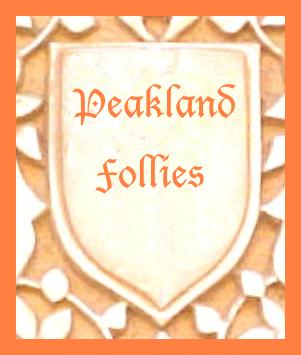8. MOW COP FOLLY
An enjoyable and easy ramble connecting two quite different landscapes, which visits one of Britains' most archetypal follies and a historic house regarded by many as being the finest timber-framed moated Elizabethan manor house in the country.
Getting There: Mow (pronounced like 'how') Cop is a small hilltop community lying twixt Congleton to the north and Stoke-on-Trent to the south. From Stoke-on-Trent take the A500(T) to Middleport. Leave the dual carriageway and cross the railway following the A527 to Tunstall. From Tunstall follow the A50 towards Kidsgrove. Halfway to Kidsgrove at Sandyford, turn right opposite the church and follow the lane to Newchapel. At the junction turn left and follow the lane through Harrishead to Mow Cop. At Mow Cop bear left then right to the large (free!) carpark beneath Mow Cop Folly.
Distance: Four miles
Map ref: Landranger Sheet 118 SJ 857 573.
Rating: Walk *** Follies and General Interest ***
This is the only linear walk in the book. It was not originally intended to be so, but having reached the furthest limit of the walk it was quickly realised that none of the alternative routes back to the start offered anything as good as the outward route! Consequently, unless you have a vehicle waiting at both ends, you will have to retrace your steps to the start. This is no great problem however, as the walk is not too far, and the journey back is just as pleasant as it was going the other way! The charming and interesting landscape more than compensates for having to retrace your steps.

Mow Cop Folly (or Mole Cop 'Castle' as it was once known,) is a folly of a classic type. This round tower with a sham ruined arch attached to it is of a pattern which has been copied by many other such structures throughout the land. 'Old John' at Bradgate Park, Leicestershire is of this type, as is St. David's Folly at Bingley in West Yorkshire. Yet Mow Cop, perched on its rocky, heavily quarried eminence is the not only the finest but the daddy of them all, being built as early as 1754 by stonemasons John and Ralph Harding for local worthy Randal Wilbraham, who intended it as an eyecatcher for his residence at Rode Hall. Although the arch was built as a ruin, the tower was not, and originally it had two storeys along with a conical roof, which, it is said, could be used as a beacon. Whether or not it was ever used thus, is uncertain, but a summerhouse it most certainly was. It was described in the Wilbraham family letters as being a place where :- "We were accustomed to boil our kettle and have tea in it on calm days." The 'Castle' stands exactly on the county boundary twixt Staffordshire and Cheshire, and was used for picnics not only by the Wilbrahams but also by the Sneyds of Keele who owned the land on the Staffordshire side! Celebrations have long been held here at Lammastide (August 1st) and 'Mow Wake' was a local gala that survived right into victorian times.
Mow Cop is not merely a place of interest to rock scramblers and folly hunters either. On 31st May 1807 it was the scene of the first Methodist open air camp meeting, organised by Hugh Bourne and William Clowes. This meeting attracted several thousand people. It heralded a split in the ranks of orthodox methodism which led to the expulsion of 'the ranters' and the ultimate establishment of Primitive Methodism.
Sing Glory Hallelujah!
The Lord is with us still!
The little cloud's increasing,
That arose upon Mow Hill.
Since then many large open air meetings have been held here. The views are spectacular. Below lies the patchwork quilt of the Cheshire Plain, with vistas embracing Alderley Edge and Delamere Forest. As with other viewpoints in this area the radio telescope at Jodrell bank is very much in evidence. Westwards lies Beeston Castle and the Welsh Hills, to the southwest Shropshire and the Wrekin. Southwards may be seen Stoke-on-Trent and the Potteries, and eastwards beyond Biddulph, the Peak District. All in all, an excellent place to be on a fine day, and a superb starting point for a ramble!
From Mow Cop Folly our route follows a path which runs just below the eastern side of the ridge a short distance before dropping into Castle Lane. Turn left, then after a few yards bear right just beyond a gate (Cobblestone Cottage), passing two low brick buildings on the left. The ordnance survey pillar is reached within a few yards. Beyond lies a quarry edge and the Old Man of Mow.
The Old Man of Mow is a perplexing oddity. 'Old Man' usually refers to a prehistoric standing stone (Maen- Menhir), but the old Man of Mow, though possibly created by man, is certainly not a megalith. A tall gritstone 'stack' standing apart from a quarried gritstone edge, it has more in common with the 'Old Man of Hoy'! It seems fairly certain that the Old Man is a rock pinnacle which has been isolated by quarrying, yet why it simply wasn't quarried away with the rest of the surrounding gritstone is not clear. One theory suggests that the top of the Old Man was the site of a prehistoric burial cairn. (other cairn sites are known to exist in the neighbourhood), or maybe a 'menhir' (man) did indeed once stand on the spot. Perhaps the delvers who dug out the quarry knew this and left the 'Old Man' in place out of superstition. Who knows?
From the Triangulation pillar, descend (carefully) a short path which runs through boulders and heather to the right of the Old Man, to join the main path below. Bear right to join a track contouring the hillside. Where this track bears right, just before reaching a radio mast, turn left onto a footpath (waymarked SCW - South Cheshire Way). This path descends the hillside alongside a wall and passes through a succession of stiles before reaching a stile and steps at the edge of woodland (Roe Park). Descend through the woods, negotiating carefully a boggy bit by a holly bush at the bottom, where a stile to the left gives access to open pasture. Continue onwards down the hillside to join a farm track, just beyond a house surrounded by ricketty sheds. The farm track (note the rich, red boulder clay) leads without complication to a junction with a small (metalled) lane. Turn left and follow the lane to the kissing gates by the railway at Ackers Crossing. Cross the railway line (take care!) and then on reaching the road junction, bear right, (past housing) to the road bridge over the Macclesfield Canal. Beyond the bridge, bear sharp right down steps to the towpath.
The tranquil (and well used) Macclesfield Canal ends at its junction with the Trent and Mersey Canal a couple of miles to the south of here, beyond which lie The Harecastle Tunnels and the Potteries. Dragonflies hover over its gentle waters and wild mint grows by the bridgeholes. Here is lowland Cheshire at its sweetest!
Pass under the bridge, and follow the towpath along the canal to the next bridge where a National Trust sign indicates that you are nearing Little Moreton Hall. Pass under this bridge then right through a stile which joins a wide, well defined footpath running to the left of the hedge along the edge of flat arable fields. The path leads without complication, via a succession of stiles, to Little Moreton Hall.
Little Moreton Hall is one of the great jewels of English Tudor architecture. This moated 'magpie' manor house, teetering on its man made island, girt by great shoals of fat, lazy goldfish, has been much photographed and much written about, and there is little (beyond my personal impressions) that I can add.
It was the home of the Moreton family, Mayors of Congleton and local landowners - collectors of taxes for the crown. Like many keen to make a fast buck from the turmoils of the time without too many worries as to how, they made their fortunes from the losses of others, buying up cheap land thrown on the markets in the wake of the Black Death, the Dissolution of the Monasteries and the Reformation. The Moretons built their first manor house here in the mid fifteenth century, and it was progressively improved upon during the 16th and early 17th centuries. In 1559 a carpenter called William Dale did extensive work on the house, part of which was a beautiful series of bay windows, displaying a a myriad of tiny glass panes, glass being a great luxury at that time. Above his creation he left this indelible mark to commend his name to the ages.
God is Al in Al thing: This windous Whire made by William Moreton in the yeare of our Lorde M.D.LIX.
Richard Dale Carpeder made thies windous by the grac of God.
In 1563 the South Wing was built for William Moreton's son John. It is believed that this light, architecturally daring structure was originally intended to have two storeys, its magnificent sixty eight feet long wainscotted long gallery being a top heavy afterthought. Afterthought or no, the gallery creaks and tilts crazily like the poopdeck of an armada galleon! Oddly enough, the apartments below (complete with 'secret' room) seem to have a solid floor, but this is in fact a primitive concrete made from lime and ash as a barrier against fire, always a worry in a wooden building.
Other things also stick in the mind:- The charming little dog kennel built into the wall of the house, facing out into the courtyard. The peaceful chapel, the mediaeval great hall with its walled up minstrel gallery. The parlour with its recently discovered Tudor wallpainting, the garderobes overhanging the moat. The list of Little Moreton's architectural charms goes on and on!
When I first visited the Hall, many years ago, all the timbers were black - so called Cheshire 'Magpie' architecture I was told. But as restoration replaces old, rotted timbers with new ones, the hall is slowly returning to its original natural colour. The 'magpie' style we are now informed, being merely the product of victorian paint, whitewash and whimsy! In the '90s we must be not only politically but also historically 'correct'. It's hard to leave Little Moreton Hall on a pleasant day. The urge is sunbathe on its extensive lawns or enjoy the peace and quiet of its knot garden. But go we must - car and home beckon.
From Little Moreton Hall the rest of the walk is simply a hike back up to Mow Cop, but you will find the return journey just as pleasing as the outward one. If desired you could navigate your way back by road as I planned to do, but it really isn't worth it; who wants to spend an hour or so dodging speeding cars when peaceful woodlands and pleasant pastures may be revisited anew and seen from a different perspective? High above, on a far horizon, once more, Mow Cop awaits!
NB. if time permits a visit may also be made to the Gardens and follies at nearby Biddulph (Just east of Mow Cop -See Appendix). A joint ticket may be purchased at Little Moreton Hall giving access to both









